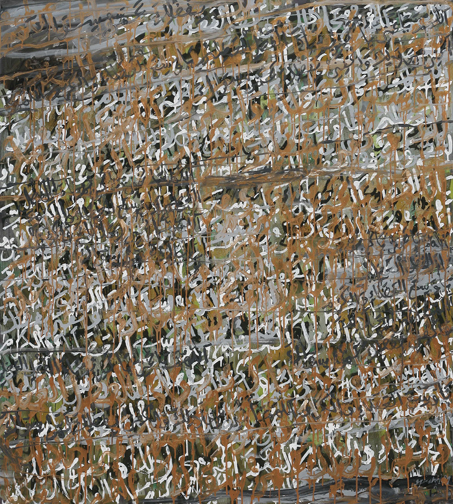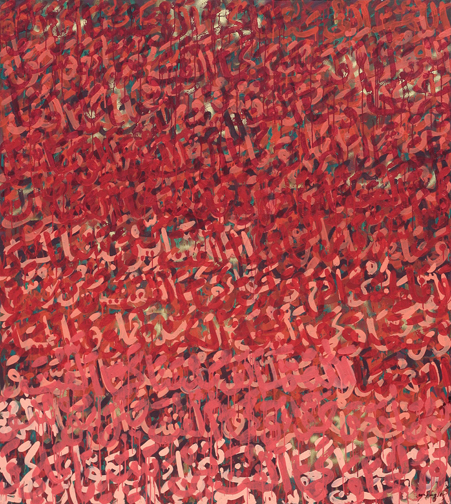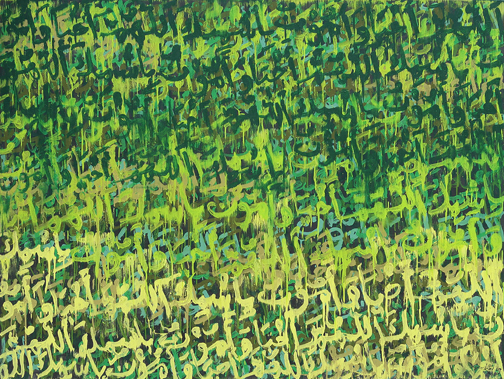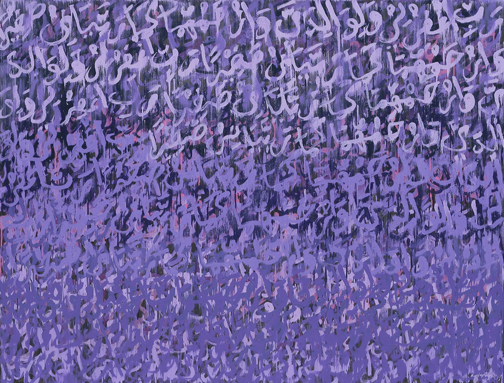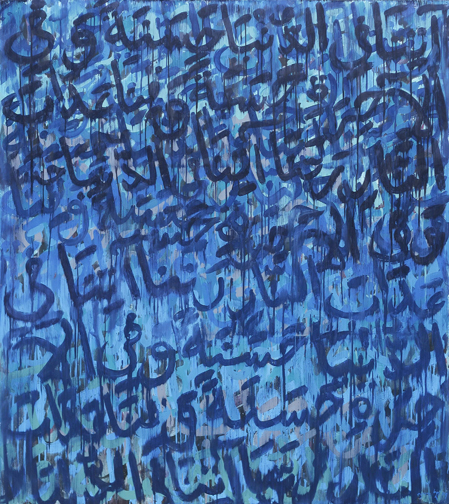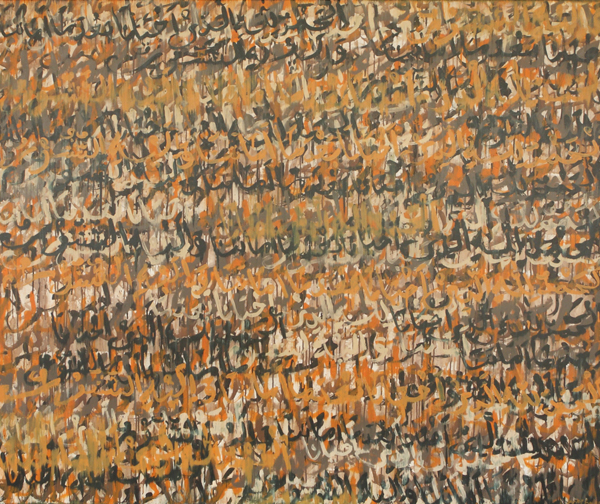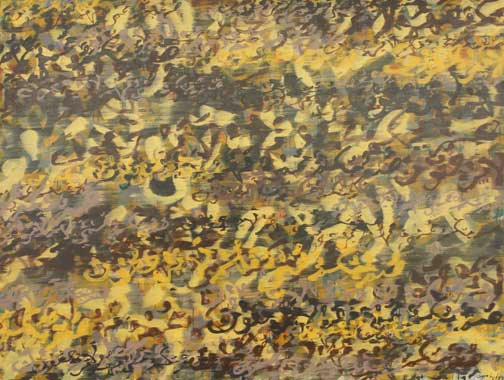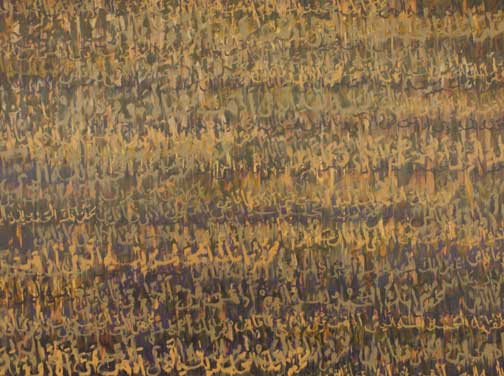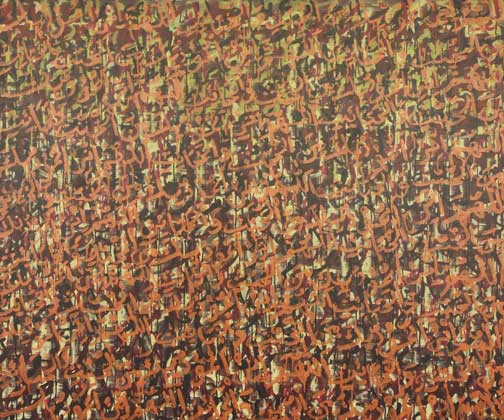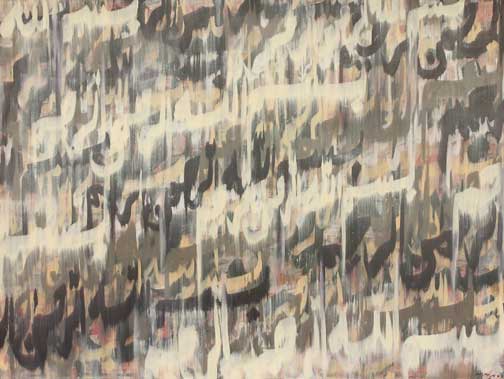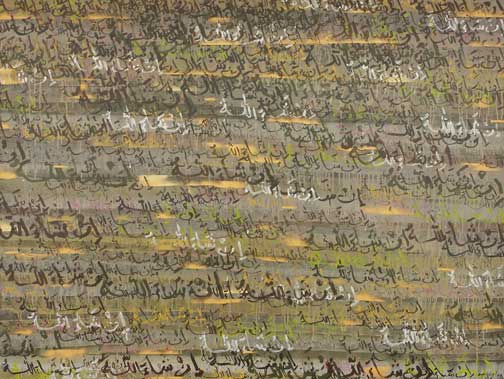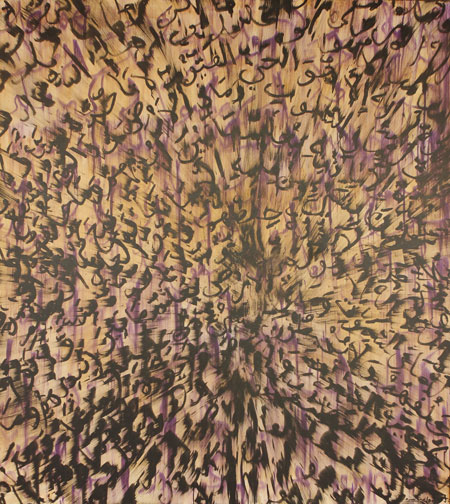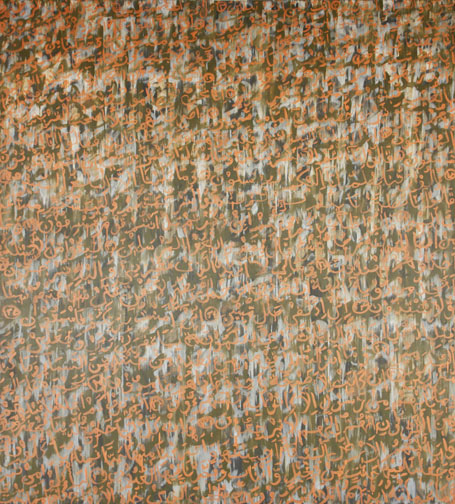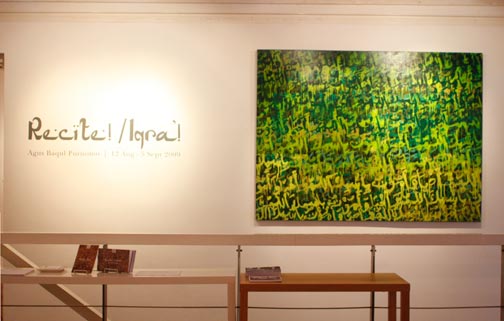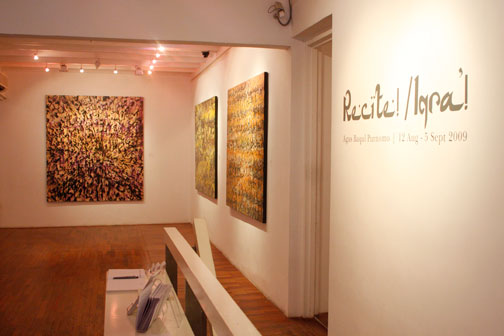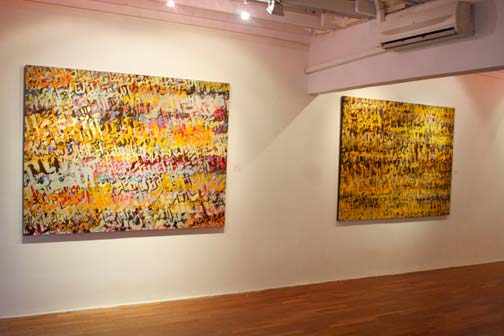Agus Baqul Purnomo
RECITE! / IQRA
It can be said that Agus is a visual artist that has the potential to effect growth in abstract painting, particularly through his ability to eloquently express four main elements in his work: rhythm, texture, colour and repetitive shapes. His choice of shapes is strengthened by an expressive use of texture, that are at times heightened with alphabets, light control, and solid colours that convey meanings of their own. Agus’s artwork presents a refreshing departure from current abstract expressions in Indonesia, which have lately been dominated by ‘pleasing’ and sterile formalism, by employing visualisations inspired by abstract expressionism, but in a context all its own.
This new series of work will be exhibited in the exhibition entitled Recite! The title of the exhibition was cited from the most significant verse in the Qur’an for every Muslims. Taken from the first five verses recited to the Prophet Muhammad, from Surah (chapter) Al-Alaq: “Iqra bismi rabbikalla dhi khalaq. Khalaqal insana min alaq. Iqra wa rabbukal akram. Alladhi ‘allama bil qalam. ‘Allamal insana malam ya’lam, ” which means “Read in the name of your Lord who created, created man from a clot. Read, for your Lord is most Generous, Who teaches by means of the pen, teaches man what he does not know.” (96: 1-5).
This series is a continuation from the artist’s previous collective exhibition entitled ‘Yasin: The Unstransable’ in Yogyakarta, where he was working closely with curator Farah Wardani. The exhibition brought forth various visual interpretations of the Surah Ya-sin, whereby Agus’s work was one of the most striking of all in the show. The collaboration between Agus and Farah lead to his solo exhibition here at VWFA, where his works continue to embrace Indonesian Islamic culture, with Agus combining calligraphy and abstract styles in painting.
The concept of this exhibition is based on the dialogue between Agus and Farah Wardani, on their identities as the average Indonesian Muslim. After the Ya-sin exhibition, Agus was inspired to explore other doas (prayers) to be interpreted visually. The prayers highlighted are a collection of those most crucial to the daily lives of Indonesian Muslims, such as prayers to be recited before a meal or bathing, a prayer to find a life partner, a prayer for travelling and others. These prayers are derived from Qur’an verses, the teachings of the Prophet, and prophetic traditions collected by Bukhari and Muslim. Typically, parents teach these prayers to their children, to instil the values of worship and Quran recitation.
Agus’ Little Book of Prayers
Agus Baqul Purnomo is no stranger to the art scene. He has been creating artworks for over a decade, since his days in college at the Indonesian Institute of Art (ISI), Yogyakarta. His works have been shown at various exhibitions in Taiwan and the United States and he has also participated in numerous visual art projects at various locations, with his works tabulating both two and three-dimensional forms.
It can be said that Agus has the potential to contribute to the growth of abstract painting through his ability to eloquently cultivate four main elements in his works: rhythm, texture, colour and repetitive shapes.
His choice of shapes is mainly strengthened by the expressive tabulation of texture, and at times with the use of alphabets, the arrangement of light, and the use of solid colours that convey meanings of their own. Agus’ artworks present a refreshing departure from current abstract expressions in Indonesia, which have lately been dominated by ‘pleasing’ and sterile formalism, by employing visualisations inspired by abstract expressionism, but in a context of its own.
I was working closely with Agus Baqul during the last Ramadhan in a collective exhibition entitled ‘Ya-sin: The Untranslatable’ in Yogyakarta. The exhibition summoned various visual interpretations of the Surah Ya-sin, whereby Agus’ work stood out the most in the show. This collaboration has led to his solo exhibition here at VWFA, in which his works continue to embrace Indonesian Islamic culture with his works combining both calligraphy and abstract styles.
Islamic teachings offer many concepts of abstraction that combine both facts and logical science. However, it is still being practiced either in an over-simplified manner, with the lack of understanding or with literal interpretations, which in turn limit its followers to reach a more in depth understanding of the Islamic faith.
Islamic art styles such as Calligraphy and ornamental forms often imply concepts of abstraction, which are non-figurative or non-verbal in its principles. This is similar to the concept of abstract modernism in Western art, which indicates the stature of Islam towards textualisation and visualisation.
Among all of the visual arts practice, calligraphy is the most popular art form among Muslims. This is because Islam is not merely a religion, but it is also a way of life as well as an artistic language that have been proliferated in both art and architecture through the teachings of Muhammad. The written word has a powerful meaning in Islam; Al-Quran literally means ‘recitation’ in the Arabic language. The Prophet Muhammad translated the ‘sabda’ of God, and great attention has been given to develop the Arabic manuscripts, which carries divine messages. The alphabets from various Al-Quran manuscripts is mainly combined with Middle Eastern ornaments, which are used as rich iconography in architecture as well as other art forms.
It is debated that apart from poets and calligraphy artists, the Muslims have never turned to artists for insights or interpretations, especially those in the line of decorative art. This assumption is no longer valid after it has been made known that Islamic decorative art is based on mathematical studies. This involves complex geometrical plans, which are strongly influenced by science and philosophy. The art of calligraphy has since become a valuable art form and in many ways developed into a dominant element in the general layout of Islam. These geometrical shapes represent a new decorative form, which symbolises unity and commandment. This complex combination was determined by mathematicians, scholars and Islamic astronomers towards the end of the classical era.
From a global contemporary art perspective where the issues of Islam and modernisation are coherent to the Western world, there is an increasing amount of interest for artworks based on Islamic perspectives. In a world that has become more multicultural, the term ‘Islamic Art’ is no longer used frequently, which is now referred to as ‘Arts of the Islamic world’, as clearly defined by Lucien de Guise in his essay in Islamica Magazine:
“The Muslim community tends to pay a lot of attention to anything that is “Islami”, with the exception of art, while some pay very little attention in regards to the subject. One of the parties who have zealously defended for the arts is the art market because of their interest in its terminology. Almost a decade ago, Sotheby’s had held a regular auction for anything that says “Islamic art”, now known as “Arts of the Islamic world”. There is no longer any awkward query about what makes an object Islamic. Thus, they are able to incorporate any sort of object that is originated from any part of the world that is considered Islamic.”
There is a need to further penetrate into the arena of Indonesian art with a newer approach that is emanated from an altogether fresh and open mind, which is consistently respected for its concept. However, this opinion is often regarded as ‘outdated’ or has the potential to cause unease because of the narrow-minded perspectives lately towards Islam. Just as proven with the extensive history of Islamic art as well as present analysis about art in the world of Islam, the practice of art still offers various ways to create an understanding beyond spirituality and identity for the Muslim community. It also offers various possibilities to the growth of the artistic region in the world of global contemporary art.
The idea of this exhibition is based on the dialogue between Agus and myself, about our faith as everyday Indonesian Muslims. After the Ya-sin exhibition, Agus was inspired to explore other prayers in order to produce more visual interpretations. The prayers highlighted are a collection of those which are familiar to the daily lives of Indonesian Muslims, such as prayers to be recited before a meal or a shower, a prayer in search of a life partner, a prayer for travelling and many others. These prayers are derived from various sources such as excerpts from Qur’an verses, the teachings of the Prophet, and prophetic traditions collected by Bukhari and Muslims. Normally, parents teach these prayers to their children, to instill the habit of worship and Qur’an recitation.
These are the prayers that will become a part of them and will be the formation of faith for the Indonesian Muslim community, be it in the rural or urban areas. This will prevent separation of the region no matter how strong the current of modernisation and secularism is that is sweeping through the era of globalisation at this very second.
Through these daily prayers, we are attracted to delve into the relationship between the modern Muslim in Indonesia with the current state of Islam by examining the teachings of Islam fostered to us when we were children and how it is sometimes intertwined with the roots of Java and Malay traditions. All these are synergised with rapid modernity in forming the innermost faith of current Muslim community in Indonesia, and probably in Malaysia too.
This is the kind of synergy Agus would like to display in his works for this exhibition, ‘Recite! Iqra’!’ These prayers are reflected from everyday spirituality that fills the life of the community. Understanding their functions (the prayers) also becomes a way to better understand the mentality of the Indonesian/Malay Muslim community.
Happy Idul Fitri and salam Ramadhan to everyone.
Wassalam,
Farah Wardani
Independent Curator
